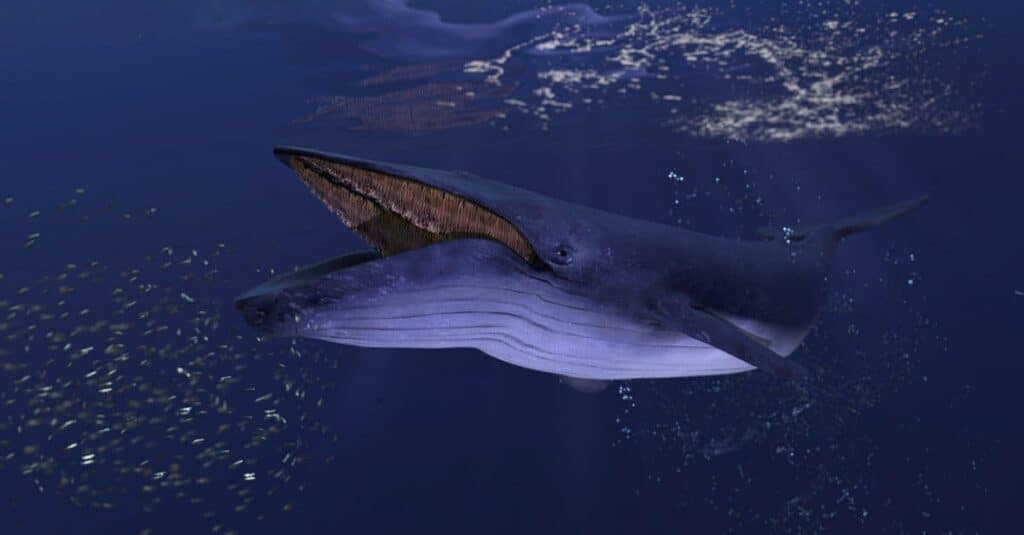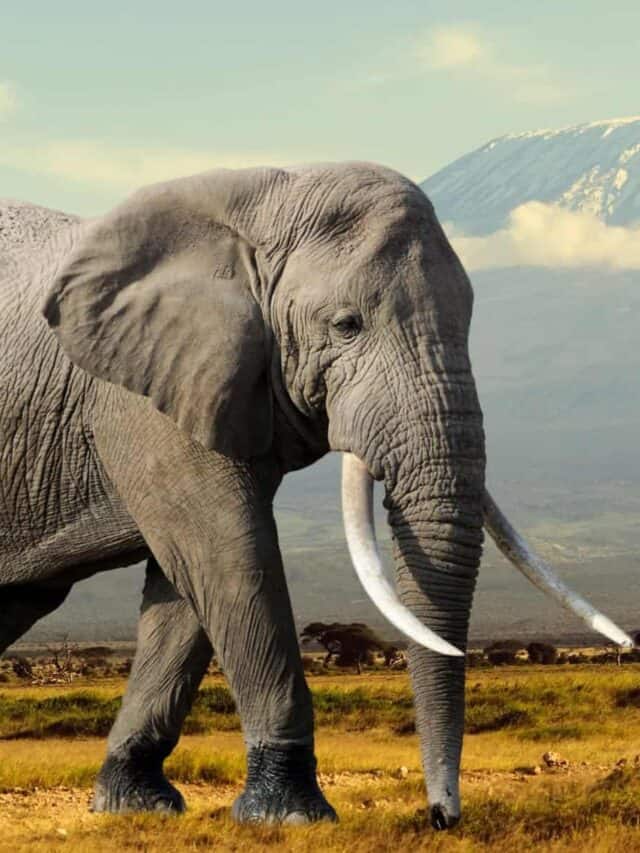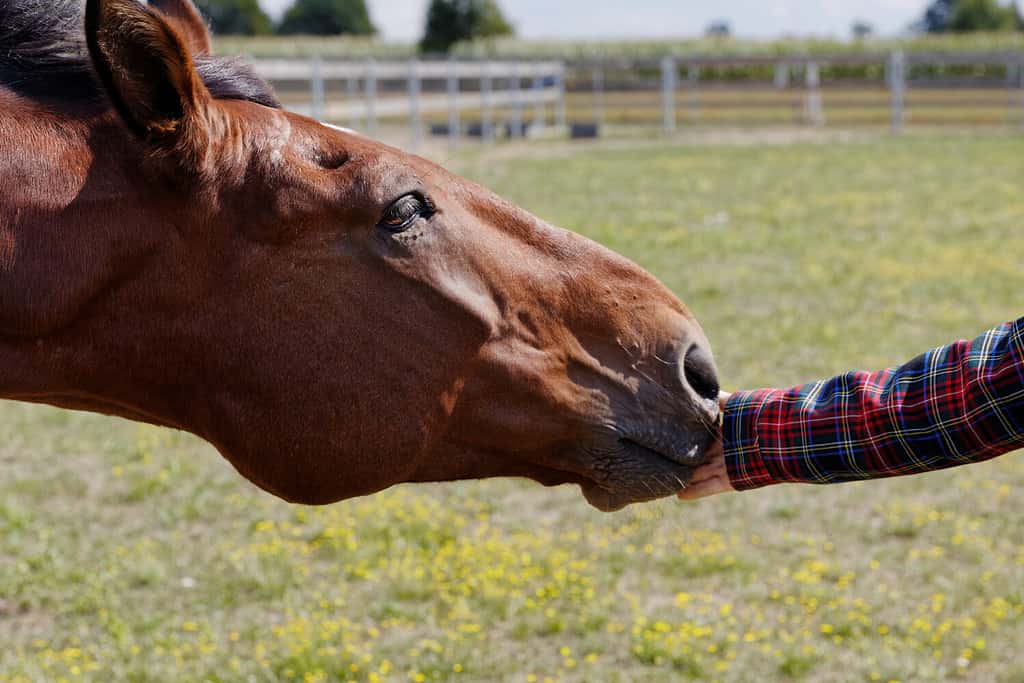Welcome to our fascinating article, where we explore the animal with the largest head in the world. As you delve into this piece, you’ll uncover some truly incredible facts about these magnificent creatures and their impressive cranial features. Whether you’re a wildlife enthusiast or simply intrigued by nature’s wonders, this article is sure to captivate your attention and leave you amazed at the remarkable diversity of life on our planet. So let’s begin our journey of discovery as we reveal which animal boasts the most sizable head in all of Earth’s fauna!
Which Animal Has the Largest Head in the World?

Blue whales are the animal with the largest head of any animal on earth.
©bekirevren/Shutterstock.com
Blue whales are the largest animals on Earth, and their heads are no exception. In fact, they have the largest head of any animal in the world. These magnificent creatures can grow up to 100 feet long and weigh as much as 200 tons – that’s equivalent to about 33 elephants!
The blue whale’s head makes up almost a third of its body length, which is necessary for it to perform one of its most impressive feats, filter feeding. Blue whales feed primarily on krill, tiny shrimp-like animals that live in massive swarms in the ocean. To catch these small prey items, blue whales open their mouths incredibly wide and take in huge volumes of water that contains thousands upon thousands of krill. Once inside their massive mouths, specialized filters called baleen plates trap the krill while allowing water to escape back out.
In addition to being impressively large and functional for feeding purposes, blue whale heads also serve another important purpose – communication. Like many marine mammals, such as dolphins or orcas (also known as killer whales), blue whales use a complex system of vocalizations ranging from low-frequency moans to higher-pitched songs lasting several minutes long. Scientists believe these sounds play an important role in mating rituals or establishing territory between individuals.
Who Has the Largest Head-To-Body Ratio?
It can be difficult to find out which creature has the largest head in relation to its body size. There are countless species that we don’t even know exist yet. Additionally, some animals, like octopuses, add another layer of complexity to the question. Octopuses have a mantle that looks like a head, but it contains all of their organs and their brain. So is this mantle considered a head or not?
The insect kingdom is home to some of the creatures with the largest heads relative to body size. Species like soldier termites and leaf-cutter ants have “big, bulky heads” that comprise nearly half their bodies. Also, certain species of flies in the family Diopsidae have very wide heads – in some cases, their heads are twice as wide as their bodies. This is likely a form of intimidation in male-to-male battles.
Female South American cycad weevils (Antliarhinus zamiae) have earned the title of having the largest head-to-body ratio in the insect world. These weevils pollinate cycads, which look like short, stubby palm trees and have been around since the dinosaur era. The structure coming from the insect’s head called a rostrum, can be up to two times as long as its body. This rostrum houses its eyes and antennae, and at the tip of it are the mandibles, which are its mouthparts. The mandibles are controlled by jaw muscles located at the base of the rostrum and are used to eat seeds or bore holes in plants to lay eggs. Cycad weevils are the species with the biggest head-to-body ratio.
Other Animals With Large Heads
There are many other animals with enormous heads. They may not be the animal with the largest head in the world, but they are impressive nonetheless. Here are our favorites.
African Bush Elephant

The African bush elephant is the largest land animal on Earth, and its head is no exception to this enormous size. With a circumference of up to 10 feet, an adult male’s head can weigh as much as 330 pounds. This massive cranium houses complex sensory organs that allow elephants to navigate their environment with precision and communicate with each other over long distances through low-frequency rumbles and trumpets. Additionally, elephants use their trunks – which are composed of some 100,000 individual muscles – for a range of tasks, including drinking, feeding, socializing, and defense. Despite its imposing size and strength, it is important to remember that the African bush elephant is also a highly intelligent and emotional creature capable of forming deep bonds with others in its herd and exhibiting behaviors such as grief after losing a loved one.
Horse

Horses are known for having large, elongated heads.
©Fotema/Shutterstock.com
A horse is a large mammal belonging to the Equidae family. They are generally known for their muscular build, long mane and tail, and their ability to run at high speeds. Horses have been domesticated by humans for thousands of years and are used for various purposes, such as transportation, recreation, sports, and even therapy.
When it comes to the size of a horse’s head, it can vary depending on the breed. However, in general, horses have relatively large heads compared to their body size. The average horse head measures around 1 meter (3 feet) from poll to muzzle.
The reason why horses have such large heads is due to their herbivorous diet consisting mainly of tough fibrous vegetation. The powerful muscles in their jaw help them grind down food while chewing.
Aside from its size, the horse’s head also plays an important role in communication with other horses as well as with humans. For example, when a horse lays back its ears or raises its head high with flared nostrils, it may indicate that they are feeling threatened or agitated.
American Bison

American Bison have large, heavy heads.
©iStock.com/Jillian Cooper
An American Bison, also known as a buffalo, is a large mammal that roamed the grasslands of North America in the millions before European settlement. Today, they can be found mainly in protected areas such as national parks and reserves. The bison has an enormous head which is one of its most distinctive features. In fact, it has the largest head of any land animal in North America! The size and weight of their heads vary depending on age and sex, but generally speaking, adult males have larger heads than females or juveniles.
The impressive size of the bison’s head is due to several factors, including its powerful neck muscles used for grazing and fighting off predators like wolves or bears. Additionally, their skulls are thick and sturdy, which helps them withstand impacts during battles with other bison or when charging into objects like trees or rocks.
Despite their massive size (an adult male can weigh up to 2,000 pounds), American Bison are surprisingly agile animals capable of running at speeds of up to 35 miles per hour! They use this speed both defensively against predators and offensively when competing for mating partners during the breeding season.
Overall, the American Bison is a fascinating creature with many unique physical traits, including its impressively large head, which serves both practical functions as well as aesthetic appeal for those lucky enough to see these majestic creatures roaming free in nature.
Basking Shark

A basking shark’s head can measure up to five feet wide.
©Chris Gotschalk / Public domain, from Wikimedia Commons, the free media repository – Original / License
A basking shark is a large, slow-moving marine fish that belongs to the family Cetorhinidae. They are found in temperate oceans around the world and can grow up to 32 feet (10 meters) long. Their most distinctive feature is their enormous head which can measure up to 5 feet (1.5 meters) wide and has a gaping mouth filled with rows of tiny teeth.
Despite their size, basking sharks are gentle creatures that feed on plankton by swimming slowly through the water with their mouths open. They are filter feeders, meaning they strain out small organisms from the water using specialized gill rakers.
Due to overfishing and accidental capture in fishing nets, basking sharks have declined significantly in numbers over the past century and are now listed as vulnerable by the International Union for Conservation of Nature (IUCN). Efforts are being made to protect them through regulations on commercial fishing and conservation programs.
Beluga Whale

Even baby beluga whales have enormous heads.
©Luna Vandoorne/Shutterstock.com
A beluga whale is a medium-sized toothed whale that belongs to the family Monodontidae. They are distinctively recognizable for their white or pale gray skin and rounded forehead, which makes up about one-third of their body length. The head of a beluga whale can weigh up to 1/3 of its total body weight, making it an animal with a large head compared to its body size.
Beluga whales have a highly developed sense of hearing and use echolocation as a tool for navigating through murky waters and locating prey. Their bulbous forehead contains an acoustic window that helps them produce sounds and receive echoes more effectively.
These fascinating creatures can grow up to 15 feet long and weigh over 3,000 pounds when fully grown. Despite being relatively small compared to other species of whales, they are incredibly agile swimmers capable of reaching speeds upwards of 20 mph.
In addition to being known for their uniquely shaped heads, beluga whales are also notable for their sociable behavior. They live in groups known as pods that can number from several individuals up to several hundred members. These pods often engage in playful behaviors such as chasing each other around or tossing objects back and forth using their noses.
Overall, these charismatic marine mammals continue to captivate people around the world with their impressive size, unique physical characteristics, and social nature, making them truly one-of-a-kind animals worth discovering!
Gorilla

A male gorillas head is 12-12 inches long.
©Kit Korzun/Shutterstock.com
Gorillas are a species of primates that belong to the family Hominidae and are native to Africa. They are one of our closest living relatives, sharing approximately 98% of their DNA with humans. Gorillas have distinct physical characteristics such as long arms, broad chests, and muscular bodies that enable them to move through dense forests with ease.
One of the most striking features of gorillas is their large heads. In fact, they have one of the largest head sizes among all primates relative to body size. The average adult male gorilla’s head measures about 12 inches in length and weighs around 15 pounds, while females’ heads measure up to ten inches in length and weigh around seven pounds.
Their massive skulls house powerful jaws filled with sharp teeth used for chewing tough vegetation like bamboo shoots or bark from trees. Additionally, these strong jaws give them an impressive bite force that can exert over 1300 PSI (pounds per square inch).
Overall, gorillas’ large heads not only contribute to their impressive physique but also play a crucial role in maintaining their dominance within social groups by intimidating potential rivals during displays of strength or aggression.
The photo featured at the top of this post is ©
Thank you for reading! Have some feedback for us? Contact the AZ Animals editorial team.







